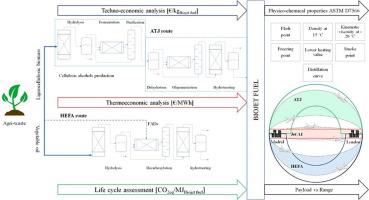Energy Conversion and Management ( IF 9.9 ) Pub Date : 2021-07-22 , DOI: 10.1016/j.enconman.2021.114534 Nicolas Vela-García 1, 2 , David Bolonio 1 , María-Jesús García-Martínez 1 , Marcelo F. Ortega 1 , Daniela Almeida Streitwieser 2 , Laureano Canoira 1

|
This study assesses an integrated biorefinery model's efficiency for biojet fuel production as Jet A1 blending component through the Alcohol-to-Jet (ATJ) and Hydroprocessed Esters and Fatty Acids (HEFA) thermochemical routes, employing lignocellulosic biomass from oleaginous crops. The ATJ process involved cellulosic ethanol production through steam explosion hydrolysis, simultaneous saccharification and co-fermentation. The anhydrous ethanol was sequentially dehydrated, oligomerized, and hydrotreated. On the other hand, the HEFA process upgraded vegetable oil from residues and fatty acid distillates. The vegetable oil was thermally hydrolyzed, decarboxylated and hydrotreated. The models were simulated in AspenPlus® v.11, achieving a specific biojet fuel production of 48 wt% for the ATJ and 87 wt% for the HEFA. In both cases, a biojet fuel mixture primarily composed of C9 to C12 isoalkanes was produced. The minimum selling price ranged between 1.01 €/kg to 1.43 €/kg. The studied routes were evaluated through exergetic and thermoeconomic analyses for optimizing. The life cycle assessment was carried out in SimaPro® v.9.0. The estimated net GHG emissions were 75 gCO2eq/MJ for the ATJ and 18 gCO2eq/MJ for the HEFA; nevertheless, significant improvements were achieved from by-product displacement credits. In both cases, the GHG emissions are under those from petroleum-derived Jet A1 production. Finally, the physico-chemical properties fulfilled the ASTM D7566 specifications, and the calculated payload vs range showed a better performance for an intermediate-range flight.
中文翻译:

从含油作物残渣生产生物喷气燃料:热经济、生命周期和飞行性能分析
本研究评估了作为 Jet A1 混合组分的生物喷气燃料生产的综合生物精炼模型的效率,通过酒精到 Jet (ATJ) 和加氢酯和脂肪酸 (HEFA) 热化学路线,使用来自产油作物的木质纤维素生物质。ATJ 工艺涉及通过蒸汽爆炸水解、同步糖化和共发酵生产纤维素乙醇。无水乙醇依次脱水、低聚和加氢处理。另一方面,HEFA 工艺从残留物和脂肪酸馏出物中升级了植物油。植物油经过热水解、脱羧和加氢处理。这些模型在 AspenPlus® v.11 中进行了模拟,实现了 ATJ 的 48 wt% 和 HEFA 的 87 wt% 的特定生物喷气燃料产量。在这两种情况下,产生9至C 12异烷烃。最低售价介于 1.01 欧元/公斤至 1.43 欧元/公斤之间。通过火用和热经济学分析对研究的路线进行了评估以进行优化。生命周期评估在 SimaPro® v.9.0 中进行。ATJ的估计净温室气体排放为 75 gCO 2eq /MJ,HEFA为 18 gCO 2eq /MJ;尽管如此,副产品置换信贷取得了显着改善。在这两种情况下,温室气体排放都低于石油衍生的 Jet A1 生产的温室气体排放。最后,理化特性符合 ASTM D7566 规范,计算的有效载荷与航程的关系显示出更好的中程飞行性能。











































 京公网安备 11010802027423号
京公网安备 11010802027423号